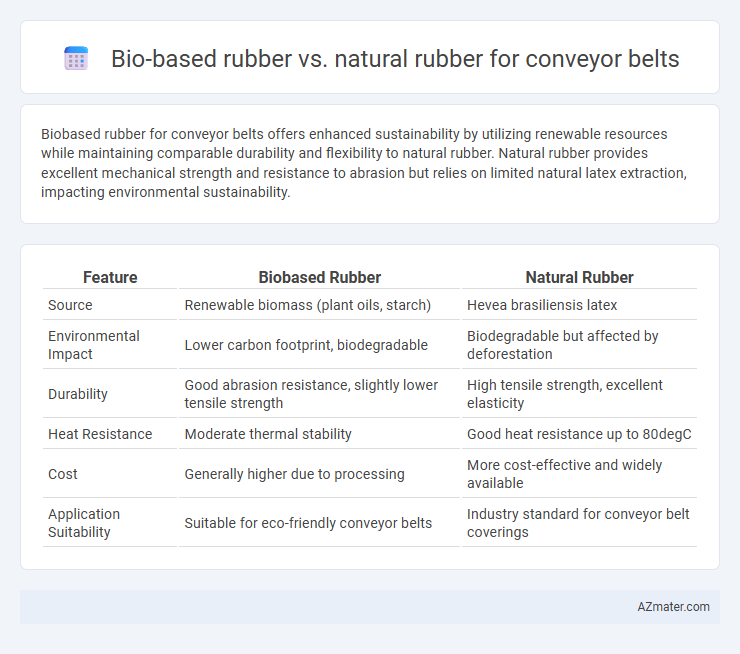Biobased rubber for conveyor belts offers enhanced sustainability by utilizing renewable resources while maintaining comparable durability and flexibility to natural rubber. Natural rubber provides excellent mechanical strength and resistance to abrasion but relies on limited natural latex extraction, impacting environmental sustainability.
Table of Comparison
| Feature | Biobased Rubber | Natural Rubber |
|---|---|---|
| Source | Renewable biomass (plant oils, starch) | Hevea brasiliensis latex |
| Environmental Impact | Lower carbon footprint, biodegradable | Biodegradable but affected by deforestation |
| Durability | Good abrasion resistance, slightly lower tensile strength | High tensile strength, excellent elasticity |
| Heat Resistance | Moderate thermal stability | Good heat resistance up to 80degC |
| Cost | Generally higher due to processing | More cost-effective and widely available |
| Application Suitability | Suitable for eco-friendly conveyor belts | Industry standard for conveyor belt coverings |
Introduction to Conveyor Belt Materials
Conveyor belts require durable and flexible materials to withstand continuous use and heavy loads, making rubber a preferred choice. Biobased rubber offers sustainable advantages by deriving from renewable resources, while natural rubber provides excellent elasticity and resistance to abrasion essential for conveyor applications. Selecting the optimal rubber type depends on balancing environmental impact, mechanical properties, and operational requirements in conveyor belt manufacturing.
Overview of Biobased Rubber
Biobased rubber for conveyor belts is derived from renewable biomass sources such as plant oils and natural polymers, offering sustainable alternatives to traditional synthetic rubbers. It emphasizes reduced carbon footprint and enhanced biodegradability while maintaining comparable mechanical properties and durability required for heavy-duty conveyor applications. Advances in biopolymer technology continue to improve the performance and cost-effectiveness of biobased rubber in industrial settings.
Understanding Natural Rubber
Natural rubber, derived from the latex of the Hevea brasiliensis tree, offers excellent elasticity, high tensile strength, and superior abrasion resistance, making it a preferred material for conveyor belts in heavy-duty industries. Its molecular structure provides natural resilience and flexibility, ensuring durable performance under continuous mechanical stress and varying operational temperatures. Compared to biobased rubber alternatives, natural rubber maintains better aging properties and resistance to fatigue, essential for the longevity and reliability of conveyor belt applications.
Environmental Impact Comparison
Biobased rubber for conveyor belts significantly reduces carbon footprint by utilizing renewable resources, unlike natural rubber which depends on extensive rubber tree plantations leading to deforestation and biodiversity loss. The production of biobased rubber involves lower greenhouse gas emissions and less soil degradation, contributing to more sustainable manufacturing processes. Lifecycle assessments reveal biobased rubber offers enhanced biodegradability and reduced ecological harm compared to conventional natural rubber.
Mechanical Properties: Strength and Durability
Biobased rubber for conveyor belts offers enhanced tensile strength and abrasion resistance compared to traditional natural rubber, resulting in superior durability under heavy loads and continuous operation. The high molecular uniformity in biobased rubber formulations improves elasticity and fatigue resistance, reducing maintenance frequency and extending belt lifespan. Natural rubber, while flexible and resilient, tends to degrade faster under thermal and oxidative stress, making biobased alternatives more advantageous for demanding industrial conveyor applications.
Cost Effectiveness and Availability
Biobased rubber for conveyor belts offers competitive cost effectiveness due to its renewable raw materials and potential for lower environmental compliance expenses compared to natural rubber. Natural rubber remains widely available globally, especially in Southeast Asia, ensuring stable supply chains and economies of scale that often reduce price volatility. The choice between biobased and natural rubber hinges on balancing initial material costs, long-term sustainability goals, and regional availability factors.
Performance in Industrial Applications
Biobased rubber for conveyor belts offers enhanced environmental sustainability with competitive abrasion resistance and tensile strength when compared to natural rubber, making it suitable for heavy industrial applications. Natural rubber provides excellent elasticity and resilience, resulting in superior impact resistance and flexibility under varying temperatures, crucial for dynamic conveyor systems in mining and manufacturing. Industrial performance of biobased rubber can be optimized through formulation adjustments, but natural rubber remains preferred for applications requiring prolonged durability and high mechanical stress endurance.
Lifecycle and Sustainability Analysis
Biobased rubber for conveyor belts offers a reduced carbon footprint compared to natural rubber, as it is derived from renewable biomass sources and incorporates less energy-intensive manufacturing processes. Lifecycle analysis indicates that biobased rubber reduces dependence on deforestation and promotes biodegradability, enhancing sustainability metrics over the entire product lifespan. Natural rubber, while biodegradable and sourced from rubber trees, often involves higher land-use impact and risks associated with monoculture plantations, making biobased alternatives a more sustainable choice in conveyor belt applications.
Market Trends and Industry Adoption
The conveyor belt market is increasingly shifting towards biobased rubber due to its sustainable sourcing and lower carbon footprint compared to traditional natural rubber, which remains widely used for its proven durability and cost-effectiveness. Industry adoption of biobased rubber is accelerating in regions with strong environmental regulations and growing demand for eco-friendly materials, driving innovation in formulations and processing technologies. Market trends indicate a steady rise in biobased rubber applications, supported by collaborations between manufacturers and research institutions aiming to enhance performance characteristics and meet stringent industry standards.
Future Prospects for Biobased Rubber in Conveyor Belts
Biobased rubber for conveyor belts offers sustainable alternatives by reducing dependency on petroleum-based materials and lowering carbon footprints. Advanced formulations improve mechanical properties and durability, closely matching or surpassing natural rubber's performance in harsh industrial environments. Ongoing innovations in biopolymer technology and eco-friendly processing methods project significant growth in biobased rubber adoption for conveyor belts, driven by increasing environmental regulations and demand for green manufacturing solutions.

Infographic: Biobased rubber vs Natural rubber for Conveyor belt
 azmater.com
azmater.com